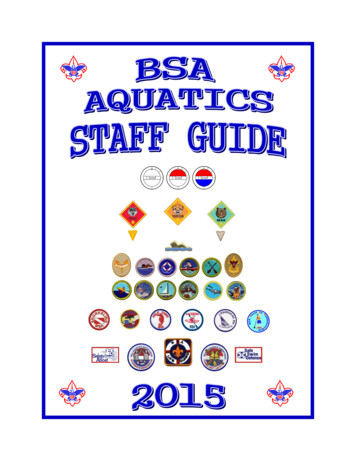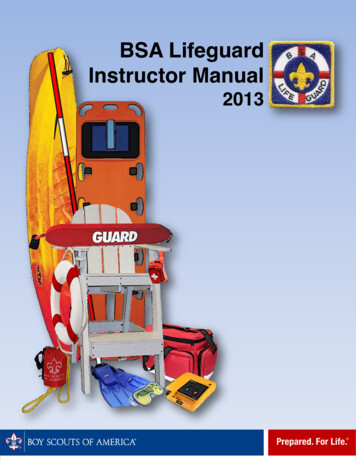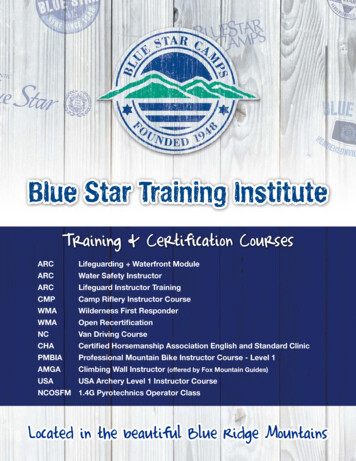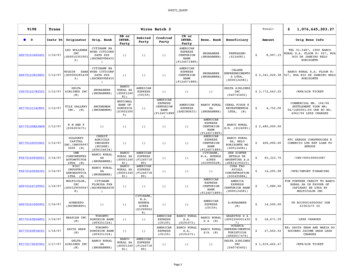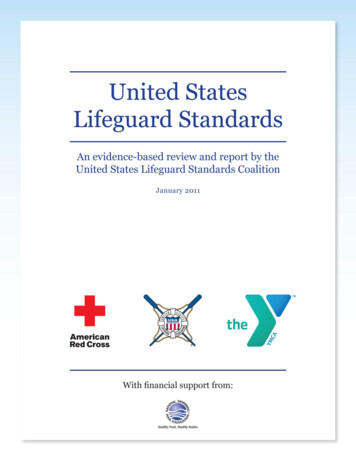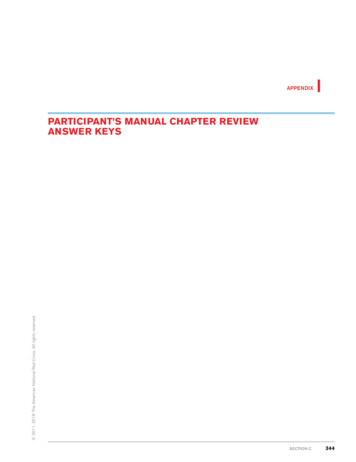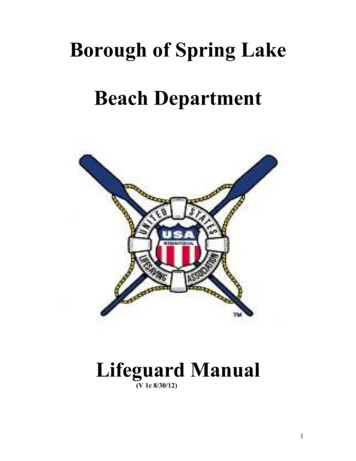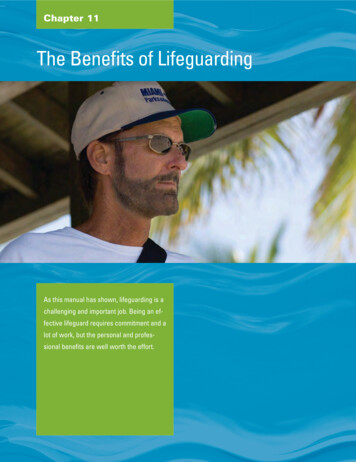
Transcription
Chapter 11The Benefits of LifeguardingAs this manual has shown, lifeguarding is achallenging and important job. Being an effective lifeguard requires commitment and alot of work, but the personal and professional benefits are well worth the effort.
182LifeguardingPERSONAL BENEFITSOne of the most important personal benefits of being asuccessful lifeguard is the satisfaction of knowing that alifeguard’s actions can save a life. A related benefit is theself-confidence built by meeting the many physical andmental challenges of the job. Other benefits of lifeguarding include— Improved self-discipline. Professional lifeguards mustbe mature and reliable. For example, they must arriveat work on time, accept assignments willingly and respond to incidents quickly and effectively. Lifeguardsalso must stay healthy and fit in order to react toemergencies with a burst of energy. This requires exercising regularly, eating properly, using sun protection and avoiding the use of alcohol and other drugs. Better decision-making skills. Decision making is important in lifeguarding, as it is in other areas in life.Lifeguards often make important decisions, many underthe intense stress of an emergency. These include— How to prevent a swimmer in trouble from becoming a drowning victim. How to ensure patron safety. When and how to make a rescue. When and how to perform first aid and provideother emergency care. Increased leadership opportunities. Professional lifeguards are leaders at their facilities and, as such, theyare expected to act responsibly, obey all of the facilityrules and lead others by their example. Development of public relations, customer service andconflict-resolution skills. Lifeguards represent their facilities to the public in a professional way. Any timethey interact with the public, their actions should promote an atmosphere of trust and goodwill. Lifeguardslearn to interact successfully with patrons and dealwith both emergency and non-emergency problems. Understanding how to properly enforce the rules.Among a lifeguard’s many responsibilities is enforcingthe facility’s rules and regulations. However, no matterhow fairly a lifeguard enforces the rules, he or shemay encounter an uncooperative patron. An effectivelifeguard must learn how to resolve these conflicts—as well as conflicts between patrons—in a respectful,positive manner. Teamwork skills development. Whenever more thanone lifeguard is on duty at the same time, those lifeguards are part of a team (Fig. 11-1). Learning to workas a member of a team is a very valuable skillbecause— A team can do its work and accomplish its goalsmore efficiently than a group of individuals workingseparately.Fig. 11-1 Individuals are better motivated to do a good jobwhen they feel part of a team. Everyone has more fun cooperating and workingtogether.PROFESSIONAL BENEFITSThe skills learned and developed as a lifeguard holdgreat value, not only for careers in aquatics or recreation, but for any career or life situation that involvesworking with others. Employers value employees withdecision-making, leadership, public relations, customerservice, conflict-resolution and teamwork skills. Selfconfidence and self-discipline are also highly valued inthe workplace.Using these skills and experiences, many lifeguardshave gone on to become successful in a variety of professions including business, law and politics. At least onepresident of the United States, Ronald Reagan, began hisprofessional career as a lifeguard.Careers in AquaticsIf aquatics is one’s chosen career, consider enrolling inan American Red Cross Lifeguard Management course,which prepares qualified candidates to become lifeguardsupervisors (Fig. 11-2). Lifeguard supervisors gain experience in minimizing risks—a skill that is crucial for movinginto higher positions in both aquatics and recreation. Lifeguard supervisors also take on a higher level of leadership responsibilities, including assisting with staff hiringand recruitment, conducting trainings and developingwork schedules.Employment as a lifeguard supervisor is the next stepon a career path at many aquatics facilities, including thefollowing: Pool or aquatic facility manager Aquatics director Aquatics and sports and leisure clubs director
The Benefits of LifeguardingFig. 11-2Other CareersWhile working as a lifeguard, one may develop an interest in working as an emergency medical technician(EMT). First aid, CPR and AED training will help one prepare and adapt to a career in the emergency medicalfield.PUTTING IT ALL TOGETHERTo be a successful professional lifeguard, candidatesmust work hard and be dedicated. However, if a candidate chooses to make the commitment, the personal andprofessional rewards gained will last a lifetime. Aquatics programmer, supervisor or coordinator Instructional specialist Swim, dive, water polo or synchronized swimmingcoachLifeguarding for LifeIt would be hard to find a better example of asuccessful lifeguard than Luiz Morizot-Leite.Morizot-Leite supervises 40 guards at HauloverBeach, Florida, and trains American Red Crosslifeguards in his spare time.Morizot-Leite is one of the most sought-after instructors, according to officials at the AmericanRed Cross of Greater Miami and the Keys. The36-year-old teaches lifeguarding, water safetyand other Red Cross courses. People keepasking for him,” said Elba Taveras, a Red Crosscoordinator. “Wherever he goes, he keeps theclass interesting.”Teaching is only the beginning of MorizotLeite’s efforts to smash stereotypes about lifeguarding and revitalize its appeal. “The publichas this image that you’re only a lifeguard whenyou are a kid, but lifeguarding is a professionalcareer,” he said. Several career lifeguards workfor him. One, a former university teacher with amaster’s degree, worked at Morizot-Leite’s facilityfor 18 years until a hip fracture forced him to retire at the age of 69. Morizot-Leite wants to belike him. “I’ll be doing this 25 years from now,”he said.Brazilian born, Morizot-Leite was 4 years oldwhen he began dreaming of being a lifeguard likehis father, who guarded for several years beforeentering medical school. After arriving in theUnited States, Morizot-Leite decided to becomean EMT to improve his lifeguard qualifications. In2003, he completed his master’s degree in sportsmanagement, which brings up another stereotype. “I hate that people think we become lifeguards because we don’t like to study,” he said.In fact, he said, his facility may soon require acollege degree.Whatever their education, lifeguards needtraining, Morizot-Leite believes. “The Red Crossgives lifeguards the foundation they need.”183
GlossaryGLOSSARYAbandonment – Ending care of an ill or injured person withoutthat person’s consent or without ensuring that someone withequal or greater training will continue that care.Abdomen – The middle part of the trunk (torso) containingthe stomach, liver and other organs.Abrasion – A wound in which skin is rubbed or scrapedaway.Active drowning victim – A person exhibiting universalbehavior that includes struggling at the water’s surfacefor 20 to 60 seconds before submerging.Anaphylactic shock – A severe allergic reaction in whichair passages may swell and restrict breathing; a form ofshock. See also anaphylaxis.Anaphylaxis – A severe allergic reaction; a form ofshock. See also anaphylactic shock.Anatomic splint – A part of the body used to immobilizean injured body part.Anatomical obstruction – Complete or partial blockage ofthe airway by the tongue or swollen tissues of the mouthor throat.Angina pectoris – Chest pain that comes and goes atdifferent times; commonly associated with cardiovasculardisease.Antihistamine – Drugs used to treat the signals of allergicreactions.Aquatic environment – An environment in whichrecreational water activities are played or performed.Aquatic safety team – A network of people in the facility andemergency medical services system who can plan for,respond to and assist in an emergency at an aquatic facility.Area of responsibility – The zone or area in which alifeguard conducts surveillance.Ashen – A grayish color; darker skin often looks asheninstead of pale.Assess – To examine and evaluate a situation carefully.Asthma – A condition that narrows the air passages andmakes breathing difficult.Asystole – A condition in which the heart has stoppedgenerating electrical activity.Atherosclerosis – A form of cardiovascular diseasemarked by a narrowing of the arteries in the heart andother parts of the body.Atria – The upper chambers of the heart.Atrioventricular node (AV) – The point along the heart’selectrical pathway midway between the atria andventricles that sends electrical impulses to the ventricles.Automated external defibrillator (AED) – An automaticdevice used to recognize a heart rhythm that requires anelectric shock and either delivers the shock or promptsthe rescuer to deliver it.Avulsion – A wound in which soft tissue is partially orcompletely torn away.Backboard – A standard piece of rescue equipment at allaquatic facilities used to maintain in-line stabilizationwhile securing and transporting a victim with asuspected head, neck or back injury.Bag-valve-mask resuscitator (BVM) – A handheldbreathing device used on a victim in respiratory distressor respiratory arrest. It consists of a self-inflating bag, aone-way valve, and a face mask and can be used with orwithout supplemental oxygen.Bandage – Material used to wrap or cover an injuredbody part; often used to hold a dressing in place.Blind spots – Areas within a lifeguard’s area ofresponsibility that cannot be seen or are difficult to see.Bloodborne pathogens – Bacteria and viruses present inblood and body fluids, which can cause disease inhumans.Bloodborne pathogens standard – A federal regulationdesigned to protect employees from exposure to bodilyfluids that might contain a disease-causing agent.Body substance isolation (BSI) precautions – Anapproach to infection control that considers all bodyfluids and substances to be infectious.Bone – A dense, hard tissue that forms the skeleton.Buddy board – A board with identification tags used tokeep track of swimmers and reinforce the importance ofthe buddy system.Bulkhead – A moveable wall placed in a swimming poolto separate activities or water of different depths.Buoy – A float in the water anchored to the bottom.Buoyancy – The tendency of a body to float or to risewhen submerged in a fluid.Buoyant – Tending to float, capable of keeping an objectafloat.Bystanders – People at the scene of an emergency whodo not have a duty to provide care.Carbon dioxide – A colorless, odorless gas; a wasteproduct of respiration.Carbon monoxide (CO) – A clear, odorless, poisonous gasproduced when carbon or other fuel is burned, as ingasoline engines.185
186GlossaryCardiac arrest – A condition in which the heart hasstopped or beats too ineffectively to generate a pulse.Cardiopulmonary resuscitation (CPR) – A technique thatcombines chest compressions and rescue breaths for avictim whose heart and breathing have stopped.Daily log – A written journal kept by lifeguards, the headlifeguard and management containing a daily account ofsafety precautions taken and significant events.Deep-water line search – An effective pattern forsearching in water that is greater than chest deep.Cartilage – An elastic tissue in the body; in the joints, itacts as a shock absorber when a person is walking,running or jumping.Defibrillation – An electrical shock that disrupts theelectrical activity of the heart long enough to allow the heartto spontaneously develop an effective rhythm on its own.Catch pool – A small pool at the bottom of a slide wherepatrons enter water deep enough to cushion their landing.Diabetes – A condition in which the body does notproduce enough insulin or does not use insulin effectivelyenough to regulate the amount of sugar (glucose) in thebloodstream.Chain of command – The structure of employee andmanagement positions in a facility or organization.Chemical hazard – A harmful or potentially harmfulsubstance in or around a facility.Chest – The upper part of the trunk (torso), containing theheart, major blood vessels and lungs.Chronic – Persistent over a long period of time.Closed wound – An injury that does not break the skinand in which soft tissue damage occurs beneath the skin.Diabetic – A person with the condition called diabetesmellitus, which causes a body to produce insufficientamounts of the hormone insulin.Diabetic emergency – A situation in which a personbecomes ill because of an imbalance of sugar (glucose)and insulin in the bloodstream.Concussion – A temporary impairment of brain function.Direct contact transmission – Occurs when infectedblood or body fluids from one person enter anotherperson’s body at a correct entry site.Conduction system – Specialized cells of the heart thatinitiate and carry on electrical activity.Disability – The loss, absence or impairment of sensory,motor or mental function.Confidentiality – Protecting a victim’s privacy by notrevealing any personal information learned about a victimexcept to law enforcement personnel or emergencymedical services personnel caring for the victim.Dislocation – The movement of a bone away from itsnormal position at a joint.Consent – Permission to provide care given by an ill orinjured person to a rescuer.Convulsions – Sudden, uncontrolled muscularcontractions.Critical incident – Any situation that causes a person toexperience unusually strong emotional reactions thatinterfere with his or her ability to function during andafter a highly stressful incident.Critical incident stress – The stress a personexperiences during or after a highly stressful emergency.Cross bearing – A technique for determining the placewhere a submerged victim was last seen, performed bytwo persons some distance apart, each pointing to theplace such that the position is where the lines of theirpointing cross.Cryptosporidium – A parasitic disease found in the fecesof infected humans or animals. It can be spread byswallowing water that has been in contact with thecontaminated feces and is difficult to kill with chlorine.Disoriented – Being in a state of confusion; not knowingplace, identity or what happened.Dispatch – The method for informing patrons when it issafe to proceed on a ride.Distressed swimmer – A person capable of stayingafloat, but likely to need assistance to get to safety. If notrescued, the person becomes an active drowning victim.Dressing – A pad placed on a wound to control bleedingand prevent infection.Drop-off slide – A slide that ends with a drop of severalfeet into a catch pool.Droplet transmission – Transmission of disease throughthe inhalation of droplets from an infected person’s coughor sneeze.Drowning – Death by suffocation when submerged inwater.Drug – Any substance other than food intended to affectthe functions of the body.Current – Fast-moving water.Duty to act – A legal responsibility of certain people toprovide a reasonable standard of emergency care; maybe required by case law, statute or job description.Cyanosis – A blue discoloration of the skin around themouth and fingertips resulting from a lack of oxygen inthe blood.Elapid snake – Family of venomous snakes that includescoral snakes, cobras, mambas and others, such as theAustralian brown snake or death adder.
GlossaryElectrocardiogram (ECG) – A graphic record produced bya device that records the electrical activity of the heartfrom the chest.Heat stroke – A life-threatening condition that developswhen the body’s cooling mechanisms are overwhelmedand body systems begin to fail.Embedded object – An object that remains embedded inan open wound.Heat-related illnesses – Illnesses, including heatexhaustion, heat cramps and heat stroke, caused byoverexposure to heat.Emergency – A sudden, unexpected incident demandingimmediate action.Emergency action plan (EAP) – A written plan detailinghow facility staff are to respond in a specific type ofemergency.Emergency medical services (EMS) personnel – Trainedand equipped community-based personnel dispatchedthrough an emergency number, usually 9-1-1, to providemedical care for ill or injured people.Emergency medical technician (EMT) – A person whohas successfully completed a state-approved emergencymedical technician training program; paramedics are thehighest level of EMTs.Emergency stop button – A button or switch used toimmediately turn off the waves or water flow in a wavepool, water slide or other water attraction in the event ofan emergency.Emphysema – A disease in which the lungs lose theirability to exchange carbon dioxide and oxygeneffectively.Engineering controls – Safeguards intended to isolate orremove a hazard from the workplace.Epilepsy – A chronic condition characterized by seizuresthat vary in type and duration; can usually be controlledby medication.Exhaustion – The state of being extremely tired or weak.Facility surveillance – Checking the facility to helpprevent injuries caused by avoidable hazards in thefacility’s environment.Fainting – A temporary loss of consciousness.Fibrillation – A quivering of the heart’s ventricles.Forearm – The upper extremity from the elbow to the wrist.Fracture – A chip, crack or complete break in bonetissue.Free-fall slide – A type of speed slide with a nearlyvertical drop, giving riders the sensation of falling.Frostbite – The freezing of body parts exposed to thecold.Heat cramps – Painful spasms of skeletal muscles afterexercise or work in warm or moderate temperatures;usually involve the calf and abdominal muscles.Heat exhaustion – The early stage and most commonform of heat-related illness; often results from strenuouswork or exercise in a hot environment.Hepatitis B – A liver infection caused by the hepatitis Bvirus; may be severe or even fatal and can be in the bodyup to 6 months before symptoms appear.Hepatitis C – A liver disease caused by the hepatitis Cvirus; it is the most common chronic bloodborne infectionin the United States.Hull – The main body of a boat.Human immunodeficiency virus (HIV) – A virus thatdestroys the body’s ability to fight infection. A result ofHIV infection is referred to as acquired immunodeficiencysyndrome (AIDS).Hydraulic – Strong force created by water flowingdownward over an obstruction and then reversing itsflow.Hypothermia – A life-threatening condition in which thebody is unable to maintain warmth and the entire bodycools below normal temperature.Hypoxia – A condition in which insufficient oxygenreaches the cells, resulting in cyanosis and changes inconsciousness and in breathing and heart rates.Immobilize – To use a splint or other method to keep aninjured body part from moving.Implied consent – Legal concept that assumes a personwould consent to receive emergency care if he or shewere physically able to do so.Incident – An occurrence or event that interrupts normalprocedure or brings about a crisis.Incident report – A report filed by a lifeguard or otherfacility staff who responded to an emergency or otherincident.Indirect contact transmission – Occurs when a persontouches objects that have the blood or body fluid of aninfected person, and that infected blood or body fluidenters the body through a correct entry site.Inflatables – Plastic toys or equipment that are filled withair to function as recommended.Inhaled poison – A poison that a person breathes into thelungs.Injury – The physical harm from an external force on thebody.In-service training – Regularly scheduled staff meetingsand practice sessions that cover lifeguarding informationand skills.187
188GlossaryInstinctive drowning response – A universal set ofbehaviors exhibited by an active drowning victim thatinclude struggling to keep the face above water,extending arms to the side and pressing down forsupport, not making any forward progress in the waterand staying at the surface for only 20 to 60 seconds.Joint – A structure where two or more bones are joined.Oxygen – A tasteless, colorless, odorless gas necessaryto sustain life.Paralysis – A loss of muscle control; a permanent loss offeeling and movement.Partial thickness burn – A burn that involves both layersof skin. Also called a second-degree burn.Laceration – A cut.Passive drowning victim – An unconscious victim facedown, submerged or near the surface.Laryngospasm – A spasm of the vocal cords that closesthe airway.Pathogen – A disease-causing agent. Also called amicroorganism or germ.Life jacket – A type of personal flotation device (PFD)approved by the United States Coast Guard for use duringactivities in, on or around water.Patron surveillance – Maintaining a close watch over thepeople using an aquatic facility.Lifeguard – A person trained in lifeguarding, CPR and firstaid skills who ensures the safety of people at an aquaticfacility by preventing and responding to emergencies.Lifeguard competitions – Events and contests designedto evaluate the skills and knowledge of individuallifeguards and lifeguard teams.Lifeguard team – A group of two or more lifeguards onduty at a facility at the same time.Peripheral vision – What one sees at the edges of one’sfield of vision.Personal flotation device (PFD) – Coast Guard-approvedlife jacket, buoyancy vest, wearable flotation aid,throwable device or other special use flotation device.Personal water craft – A motorized vehicle designedfor one or two riders that skims over the surface of thewater.Ligaments – A tough, fibrous connective tissue that holdsbones together at a joint.Pier – A wooden walkway or platform built over thewater supported by pillars that is used for boats to dock,fishing or other water activities.Material Safety Data Sheet (MSDS) – A form thatprovides information about a hazardous substance.Poison – Any substance that causes injury, illness ordeath when introduced into the body.Mechanical obstruction – Complete or partial blockageof the airway by a foreign object, such as a piece of foodor a small toy, or by fluids, such as vomit or blood.Poison Control Center (PCC) – A specialized kind ofhealth center that provides information in cases ofpoisoning or suspected poisoning emergencies.Muscle – Tissue in the body that lengthens and shortensto create movement.Policies and procedures manual – A manual thatprovides detailed information about the daily andemergency operations of a facility.Myocardial infarction – A heart attack.Nasal cannula – A device used to deliver oxygen to abreathing person; used mostly for victims with minorbreathing problems.Negligence – The failure to follow the standard of care orto act, thereby causing injury or further harm to another.Nonfatal submersion – To survive, at least temporarily,following submersion in water (drowning). Also known asnear drowning.Non-rebreather mask – A mask used to deliver highconcentrations of oxygen to breathing victims.Occupational Safety and Health Administration (OSHA) –A government agency that helps protect the health andsafety of employees in the workplace.Open wound – An injury to soft tissue resulting in a breakin the skin, such as a cut.Opportunistic infections – Infections that strike peoplewhose immune systems are weakened by HIV or otherinfections.Preventive lifeguarding – The methods that lifeguardsuse to prevent drowning and other injuries by identifyingdangerous conditions or behaviors and then taking stepsto minimize or eliminate them.Professional rescuers – Paid or volunteer personnel,including lifeguards, who have a legal duty to act in anemergency.Public address system – An electronic amplificationsystem, used at an aquatic facility so thatannouncements can be easily heard by patrons.Puncture – An open wound created when the skin ispierced by a pointed object.Purkinje fibers – A vast network of microscopic fibers,which spread electrical impulses across the heart.Rapids ride – A rough-water attraction that simulateswhite-water rafting.
Glossaryopposite shore and estimating the victim’s position alongthat line. See also cross bearing.Reaching assist – A method of helping someone out ofthe water by reaching to that person with your hand, legor an object.Sink – To fall, drop or descend gradually to a lower level.Reaching pole – An aluminum or fiberglass pole, usually10- to 15-feet long, used for rescues.Sinoatrial (SA) node – The origin of the heart’s electricalimpulse.Refusal of care – The declining of care by a victim; thevictim has the right to refuse the care of anyone whoresponds to an emergency.Soft tissue – Body structures that include the layers ofskin, fat and muscles.Rescue board – A plastic or fiberglass board shaped likea surf board that is used by lifeguards to paddle out andmake a rescue.Rescue tube – A 45- to 54-inch vinyl, foam-filled tube withan attached tow line and shoulder strap that lifeguardsuse to make rescues.Respiratory arrest – A condition in which breathing hasstopped.Respiratory distress – A condition in which breathing isdifficult.Resuscitation mask – A pliable, dome-shaped device thatfits over a person’s mouth and nose; used to assist withrescue breathing.RID factor – Three elements—recognition, intrusion anddistraction—related to drownings at guarded facilities.Ring buoy – A buoyant ring, usually 20 to 30 inches indiameter; with an attached line, allows a rescuer to pull avictim to safety without entering the water.Risk management – Identifying and eliminating orminimizing dangerous conditions that can cause injuriesand financial loss.Rules – Guidelines for conduct or action that help keeppatrons safe at pools and other swimming areas.Runout – The area at the end of a slide where waterslows the speed of the riders.Safety check – An inspection of the facility to find andeliminate or minimize hazards.Scanning – A visual technique used by lifeguards toproperly observe and monitor patrons participating inwater activities.Seizure – A disorder in the brain’s electrical activity,marked by loss of consciousness and often byconvulsions.Shepherd’s crook – A reaching pole with a large hook onthe end. See also reaching pole.Shock – A life-threatening condition in which thecirculatory system fails to deliver blood to all parts of thebody, causing body organs to fail.Sighting – A technique for noting where a submergedvictim was last seen, performed by imagining a line to theSpa – A small pool or tub in which people sit in rapidlycirculating hot water.Spasm – An involuntary and abnormal musclecontraction.Speed slide – A steep water slide on which patrons mayreach speeds in excess of 35 mph.Spinal column – Small bones that extend from the baseof the skull to the tip of the tailbone that protect thespinal cord.Spinal cord – A bundle of nerves extending from the baseof the skull to the lower back and protected by the spinalcolumn.Splint – A device used to immobilize body parts; applyingsuch a device.Spokesperson – The person at the facility designated tospeak on behalf of others.Sprain – The stretching and tearing of ligaments andother tissue structures at a joint.Standard of care – The minimal standard and quality ofcare expected of an emergency care provider.Standard precautions – Safety measures, such as bodysubstance isolation, taken to prevent occupational-riskexposure to blood or other potentially infectiousmaterials, such as body fluids containing visible blood.Starting blocks – Platforms from which competitiveswimmers dive to start a race.Sterile – Free from germs.Stern – The back of a boat.Stoma – An opening in the front of the neck throughwhich a person whose larynx has been removedbreathes.Strain – The stretching and tearing of muscles ortendons.Stress – A physiological or psychological response toreal or imagined influences that alter an existing state ofphysical, mental or emotional balance.Stroke – A disruption of blood flow to a part of the brain,causing permanent damage.Submerged – Underwater, covered with water.189
190GlossarySun protection factor (SPF) – The ability of a substanceto prevent the sun’s harmful rays from being absorbedinto the skin; a concentration of sunscreen.Sunscreen – A cream, lotion or spray used to protect theskin from harmful rays of the sun.Superficial burn – A burn involving only the outer layer ofskin, the epidermis, characterized by dry, red or tenderskin. Also referred to as a first-degree burn.Surveillance – A close watch kept over someone orsomething, such as patrons or a facility.Universal precautions – Practices required by the federalOccupational Safety and Health Administration (OSHA) tocontrol and protect employees from exposure to bloodand other potentially infectious materials.Vector-borne transmission – Transmission of a diseaseby an animal or insect bite through exposure to blood orother body fluids.Ventricles – The two lower chambers of the heart.Ventricular fibrillation (V-fib) – An abnormal heart rhythmcharacterized by disorganized electrical activity, whichresults in the quivering of the ventricles.Thermocline – A layer of water between the warmer,surface zone and the colder, deep-water zone in a bodyof water in which the temperature decreases rapidly withdepth.Ventricular tachycardia (V-tach) – An abnormal heartrhythm characterized by rapid contractions of theventricles.Throwable device – Any object that can be thrown to adrowning victim to aid him or her in floating.Vertebrae – Small bones that make up the spinal column.See also spinal column.Throwing assist – A method of helping someone out ofthe water by throwing a floating object with a lineattached.Waterfront – Open water areas, such as lakes, rivers,ponds and oceans.Tornado warning – A warning issued by the NationalWeather Service notifying that a tornado has beensighted.Tornado watch – A warning issued by the NationalWeather Service notifying that tornadoes are possible.Waterpark – An aquatic theme park with attractions suchas wave pools, speed slides or winding rivers.Work practice controls – Employee and
successful lifeguard is the satisfaction of knowing that a lifeguard’s actions can save a life. A related benefit is the self-confidence built by meeting the many physical and mental challenges of the job. Other benefits of lifeguard-ing include— Improved self-discip
